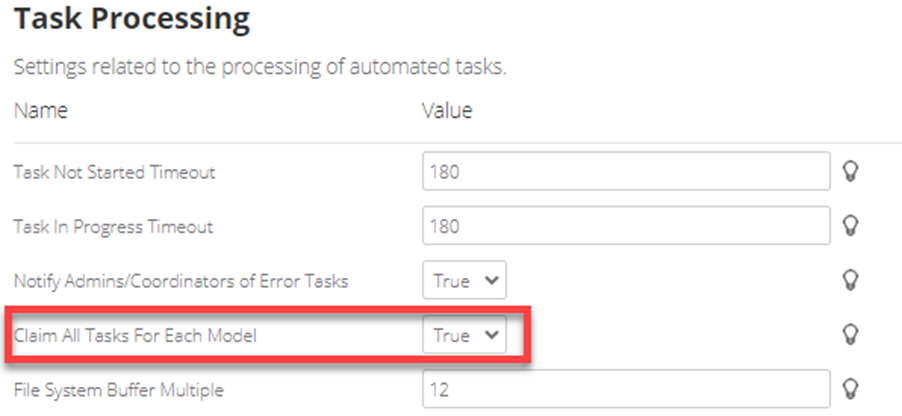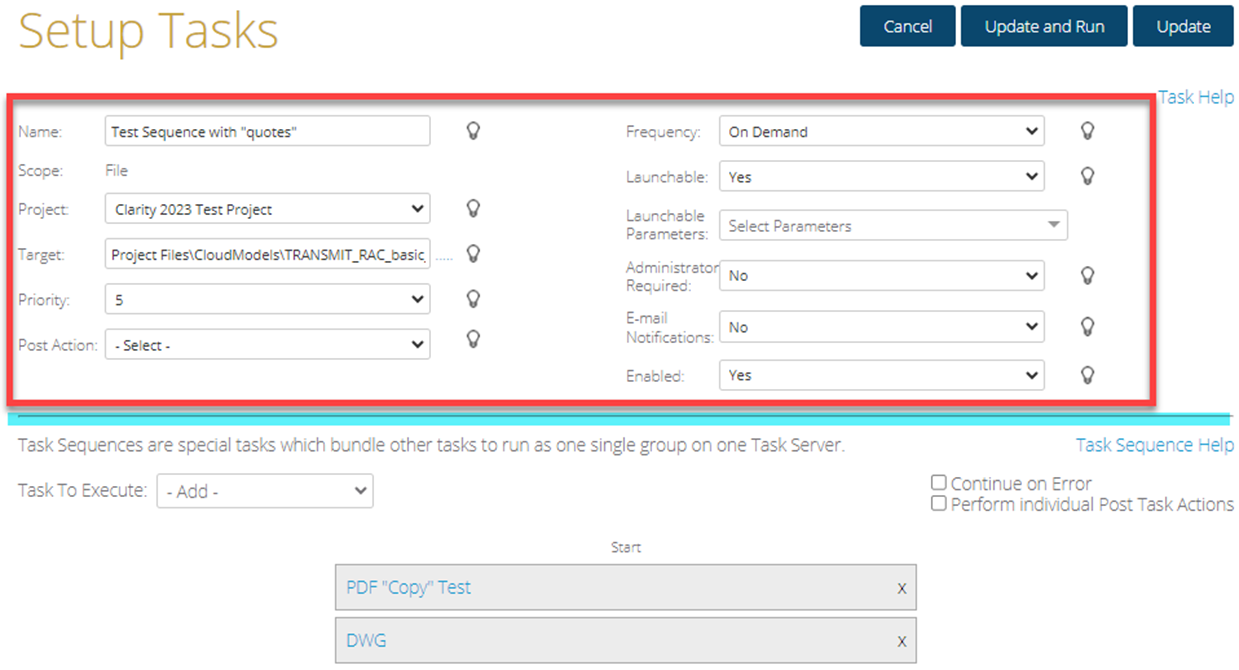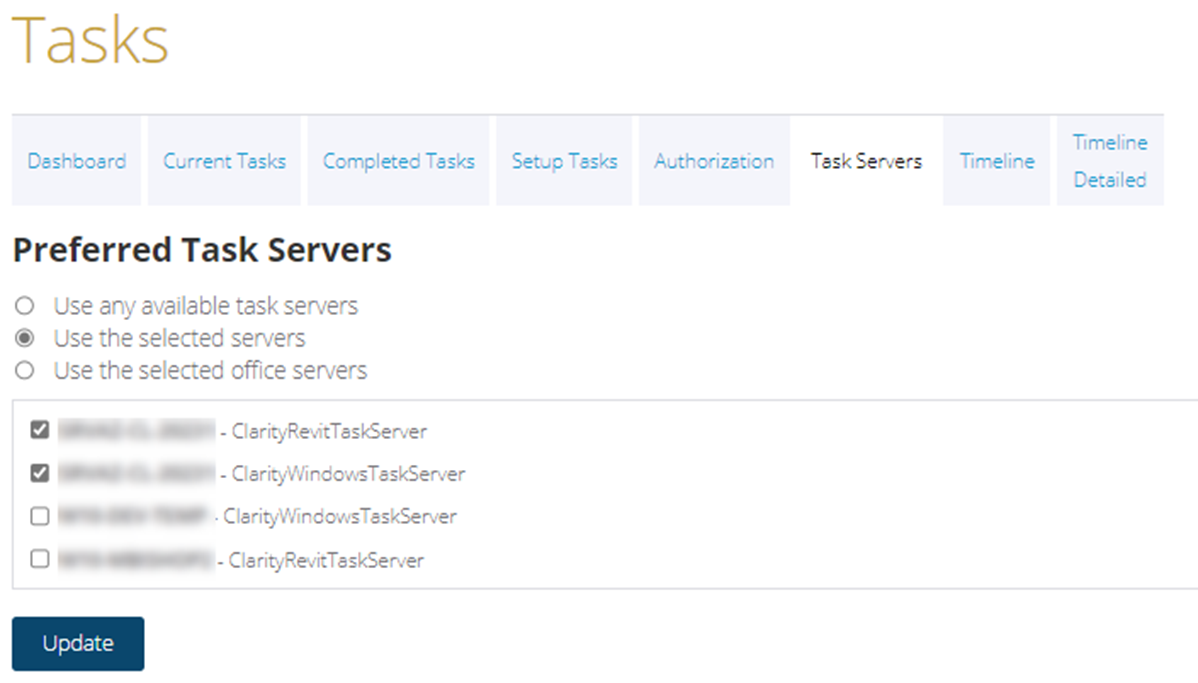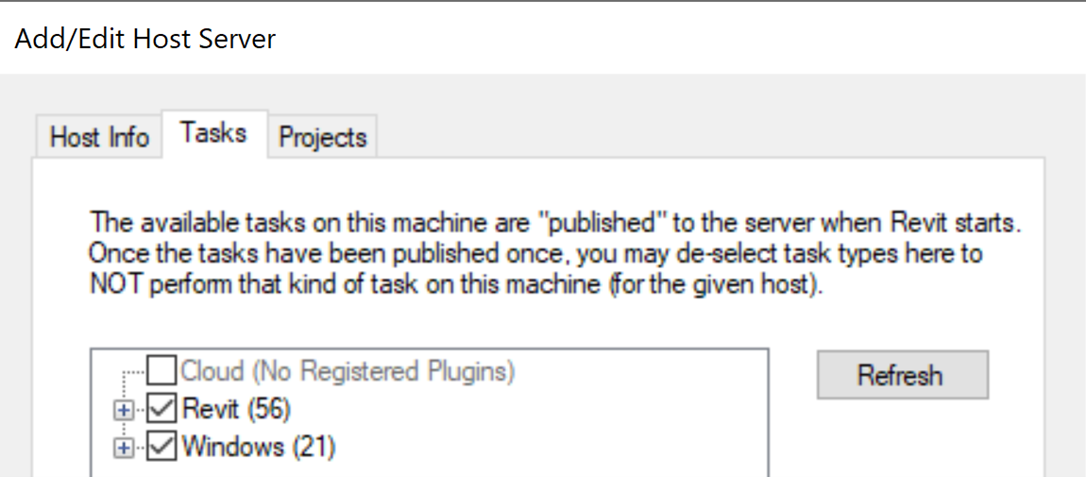Clarity Task Processing - Task Order and Identity
There are several factors that control or impact task processing, please refer to the information below.
Types of Task Servers
There are several types of Task Servers that can be enabled in the Clarity task tray. For each of these, the proper identity must be associated to it. For Revit tasks, the logged in windows session should be the designated Clarity account. For the Windows task server, the service account identity needs to be the “log on” in that service. Forge requires credentials and a key.
- Clarity Revit Task Server
- This will process tasks that require opening the Revit model.
- For 360 projects we will use the Autodesk credentials signed into Revit or the desktop connector.
- Clarity Windows Task Server
- This will process tasks that don’t require opening the Revit model.
- This also applies to Autocad tasks.
- For 360 projects, we use the Autodesk credentials assigned to the project in Clarity.
- Autodesk Forge
- This is a paid service through Autodesk.
- Clarity Cloud (2024+)
- This can process a small list of task types.
Task Priority
Each task has a priority set to it that controls whether it is more or less critical than another. The lower the number, the higher it is in the line of tasks.

IMPORTANT NOTE
This however can be overridden when tasks are in the queue by prioritizing it, which pushes the task to a priority 1 and moves it up in the queue.

Server Task Server Settings
This is set from the Server tab, Settings
Claim all tasks for each model, will process all tasks in the queue for that same model when set to True, so whichever task server grabs it, it will do all of the tasks for that model.
If that setting is False we can distribute the tasks to other task servers with a lighter load…unless the task is part of a sequence or specific task servers are set in the project or on the task servers.

Scheduled Tasks
In addition to the priority, and the server and task server settings the task will run on the set schedule, unless, it is set to Only on Change. When set to only on change, it will only run at the scheduled time, if we see that the target model has changed for that model when the task is a File Scope. If the task is a project scope, the same is true, except if any model changed it will run.
If you want the task to always run on schedule, do not select Only on Change.
We base the “change” on the date we see on the project home page, if it is different it will run, if not, it won’t.

Scheduled tasks will run in the timezone of the Server, so keep that in mind if you have task servers in different timezones.
Scheduled tasks must be “Enabled” in the task setup, or they won’t run on schedule.
Finally, the Monitoring service is what takes care of scheduled tasks, so if that service isn’t running on the host, scheduled tasks won’t run. You can see if the service is running on the Server tab, Central Host.
Task Sequence
IMPORTANT NOTES:
You cannot mix File scoped and Project scoped tasks.
You cannot mix Revit task server tasks with Windows task server tasks, they must be the same task processor type task.
It’s best to do the sequence either by model, or by task types.
- For example a sequence for the Arch model to run a pdf, dwg and navis tasks
- Or
- Several models to run the Revit DBX, Model Metrics and Performance Advisor tasks, with worksets None.
A task sequence bundles together multiple tasks in a Project, so that they will run together, in a single operation, in a guaranteed sequence.
That means, that regardless of the server settings, the targets in this task will all run at the same time and in the order specified in the task setup. If you are running a sequence on multiple targets, this could cause issues with tasks failing due to timeout issues.
The task server that claims the sequence will do all of the tasks in the sequence, for all models, in one session.
The settings above the line, will override settings in the individual tasks: target, priority, email notifications, enabled are replaced with the top configuration of the Task Sequence, with one exception:
- For any configured Post Action on the individual task, you can set the Task Sequence to process the individual task actions. All of the files produced by all of the tasks in the Task Sequence will be compiled and processed by a Post Action configured on the Task Sequence.

Setting Task Servers in the Project
This applies to all task types in the project.
If there are task servers specified in the project, that will override the ability to distribute the tasks to task servers not selected in the project, or on the task servers.

Task Server Settings for Projects and Tasks
In addition to all of the above, the task servers can also play a role in this.
If you select the Server and Edit, you can make additional configuration changes that apply to task processing.
We can specify projects and or tasks that the task server will do.
If you Enable Project Filtering, no tasks will process on that task server unless that project is checked. New projects do not automatically get checked, you would need to do that manually.


Other Task Server Settings
The task server Clarity version is also something to consider since not all versions support the same versions of Revit. Additionally, not all versions of Revit may be configured to run on the task server.
The task server might not be configured to run during certain times, which would make it unable to claim tasks.

Windows and 360 Credentials
If the task server is logged in with credentials other than the designated Clarity account, we may not be able to process certain tasks due to permission issues. This could also be true, if the task server is configured to allow multiple Windows logins.
For 360 projects, the 360 identity signed in on the task server must have access to the models in Revit.
For the Clarity Windows task server, we use the credentials assigned to the project.
Miscellaneous Considerations
PDF Tasks
For PDF tasks, only the Clarity pdfx and Revit PDF (2022 +) can run multiple pdf tasks at the same time, assuming you have the task server configured to run multiple Revit Sessions.
Memory Consumption
If a task server is over the specified memory consumption, it will not take more tasks, even if configured to run multiple sessions, until the value is below the specified setting.
Addin Missing
Some tasks require addins, if they are not installed on the task server, it will not process the task. Some addins are version specific.
Wrong Version
If the wrong version is specified for a 360 project we will not be able to claim the task and it will sit in the queue until it times out.
Additional Configuration
Some task types require additional configuration to allow them to run on the task server ie: Autocad tasks.